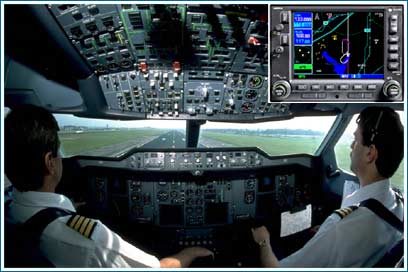Non-Aviation
Agriculture
Satellite navigation is helping farmers and agribusinesses to become more productive and efficient in their farming practices. Today, many farmers use satellite navigation to conduct precision farming operations such as chemical and fertilizer application. Satellite navigation also provides location information that enables farmers to plow, harvest, map their fields, and mark areas of disease or weed infestation - any time of day or night.
Top
Environment
Satellite navigation gives decision-makers the ability to combine accurate position data with descriptive information about the environment, which is gathered across many kilometers of terrain. It can be used to survey disaster areas and map the movement of environmental disasters, such as forest fires and oil spills, and how fast they are spreading. Satellite navigation mapping of environmental phenomena such as "El Ni�o" helps to save lives and protect property.
Top
Marine
Satellite navigation provides unprecedented accuracy and capabilities for mariners and transportation managers. Underwater surveying, buoy placement, navigational hazard location, and mapping are increasingly being executed through the use of satellite navigation signal data. Commercial fishing fleets use satellite navigation to navigate to optimum fishing locations and to track fish migrations. Access to fast and accurate position, course, and speed information will save time and fuel through more efficient traffic routing.
With the advent of GPS, exact positional information is available to pilots. This enables direct routes, reduced flight times and reduced fuel consumption.
Top
Public Safety
Satellite navigation is fast becoming an industry standard for location information used by emergency and other specialty fleets. Location and status information provided to public safety systems offers managers a quantum leap forward in efficient operation of their emergency response teams. The ability to effectively identify and view the location of police, fire, rescue, and individual vehicles or boats means a whole new way of doing business.
Top
Rail
Many rail systems are comprised of long stretches of single track. Precise knowledge of where a train is located is essential to prevent collisions, maintain smooth flow of traffic, and minimize costly delays due to waiting for clearance for track use. Satellite navigation provides a sound position-locating capability for rail traffic management systems, be it to manage the movement of cars and engines in switch yards, or to ensure the safety of work crews. Current technology will also allow for fully automated train control through the use of a differential GPS capability, digital maps and onboard inertial units.
Top
Recreation
Satellite navigation technology has helped to overcome many of the hardships and hazards associated with recreation. Portable receivers now allow users to traverse trails with confidence and to know precisely where they are at all times. Outdoorsmen use it to stay apprised of location, heading, bearing, speed, distance, and time. With satellite navigation, outdoor enthusiasts can accurately record any location and return to that precise spot time and again; and they can do it anywhere, and at any time.
Top
Space
Satellite navigation is revolutionizing and revitalizing the way nations operate in space - helping to manage, track, and control satellites in orbit. By using space-borne and specialized algorithms, a satellite will soon be capable of navigating itself, making ground stations simpler and requiring fewer operators. Future booster rockets and reusable launch vehicles will launch, orbit the earth, return, and land, all under automatic control using guidance provided by satellite navigation systems.
Top
Ground Transportation
The capabilities of satellite navigation, when coupled with communications and modern computerized management systems, can help meet many of the transportation challenges facing all modes of surface transportation. Currently, it is being used to add a new dimension for automatic vehicle location and in-vehicle navigation systems.
It will also allow for automatic toll collection on toll roads without having to establish manned toll booths. Delivery companies will be able to plan routes for deliveries in the optimum efficiency. All of the above can provide a source of revenue for the Government and assist in funding of an integrated transportation system.
Top
Surveying
Satellite navigation can be used for simple surveying tasks, such as defining a property line or for complex things like building infrastructure in urban centers. Locating a precise point of reference used to be very time consuming. With this revolutionary technology, however, two people can survey dozens of control points in a single hour. Surveying and mapping of roads and rail systems can also be accomplished from mobile platforms, saving valuable time and money.
Top
Timing
With the accuracy of atomic clocks, satellite navigation systems are used to synchronize clocks and events around the world. GPS time and information is extremely precise - to the nanosecond. It is so precise, in fact, that paging companies depend on these satellites to synchronize the transmission of data packets throughout their systems. Investment banking firms also rely on this service every day so international transactions can be recorded simultaneously.
The ultimate applications for GPS are hard to predict. In a world that changes with each new day, one universal truth remains - time.
Top

